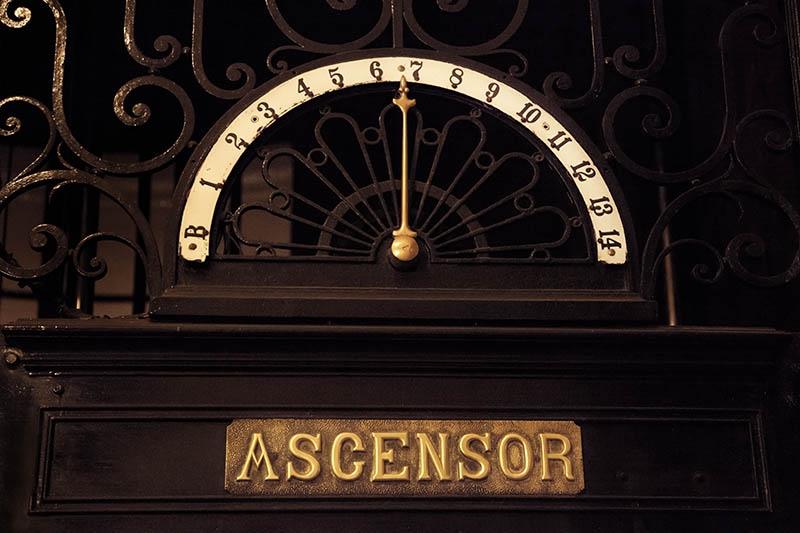The history of lifts
Contents |
[edit] Introduction
Lifts are vertical modes of transportation that move people or goods between storeys. The earliest known record of a lift can be traced back to Roman architect Vitruvius who reported Archimedes to have built the first one in 236 BC.
At the time, lifts were made from hemp rope and powered by animals or people; a vast difference to the modern lift. Over the years, lifts improved as construction and technology advanced, until they because what we see today.
[edit] Before Industrialisation
In a pre-industrial era, lifts were very different to its contemporary counterparts. In the year 1000, al-Muradi in his Book of Secrets told of a contraption similar to a lift that was used to raise a battering ram to destroy a fortress in Islamic Spain.
King Louis XV ordered the construction of a passenger lift, called ‘flying chair’, in the 18th century; more specifically, in 1743. The lift was installed outside the King’s balcony at the Chateau de Versailles and was operated by hand.
In 1793, the first screw drive lift was created by Ivan Kulibin and installed in the Winter Palace. This marked a significant step in lift history, as it was the precursor to the modern passenger lift.
[edit] The Industrial Revolution
Lifts that stemmed from steam-powered technology were only created in the 19th century after industrialisation made it possible to move large volumes of goods in mines and factories. In 1823, London architects Burton and Hormer constructed the ‘ascending room’, a tourist attraction powered by steam. It offered a unique panoramic view of London.
Sir William Armstrong created the hydraulic crane in 1846 for the purposes of loading cargo onto ships. It used a water pump and worked with water pressure to raise and lower the platform. Counterweights and balances were also applied.
[edit] From the 1850s to the 1900s
In 1852, in New York, Elisha Otis pioneered the safety lift, which ensured the cab wouldn’t fall if the cable snapped. The Equitable Life Building, in New York, was the first in the world to have passenger lifts in in 1870, and the first electric lift was invented in 1880 by Werner von Siemens in Germany. Alexander Miles, an inventor from the US, invented the automated doors.
The first hydraulic lift with push buttons (and without a driver) was operated on 1894, and the Paris Universal Exhibition had its first lift operated in 1900. By this year, automated lifts were available, although many people chose not to use them. A lift operator strike occurred in 1945, in New York, as well as the adoption of an emergency stop button, telephone and automated voice.
[edit] Modern lifts
Argentina saw the first vacuum lift offered commercially in 2000. The number of buildings over 200 m tripled since the year 2000, which also meant that more lifts were installed and new and improved technologies were developed. Lifts without ropes are already being developed.
[edit] Find out more
[edit] Related articles on Designing Buildings Wiki
- Considerations When Installing a Residential Lift.
- Lifts and Escalators: A Quality Perspective.
- Lifts and Their Special Operating Modes.
- Lifts for buildings.
- Lifts for office buildings.
- The science of lifts.
- The world's fastest lifts.
- Top factors to consider when planning to install a lift.
- Winchester House.
--Nathan Massey 14:25, 11 Jul 2017 (BST)
Featured articles and news
RTPI leader to become new CIOB Chief Executive Officer
Dr Victoria Hills MRTPI, FICE to take over after Caroline Gumble’s departure.
Social and affordable housing, a long term plan for delivery
The “Delivering a Decade of Renewal for Social and Affordable Housing” strategy sets out future path.
A change to adoptive architecture
Effects of global weather warming on architectural detailing, material choice and human interaction.
The proposed publicly owned and backed subsidiary of Homes England, to facilitate new homes.
How big is the problem and what can we do to mitigate the effects?
Overheating guidance and tools for building designers
A number of cool guides to help with the heat.
The UK's Modern Industrial Strategy: A 10 year plan
Previous consultation criticism, current key elements and general support with some persisting reservations.
Building Safety Regulator reforms
New roles, new staff and a new fast track service pave the way for a single construction regulator.
Architectural Technologist CPDs and Communications
CIAT CPD… and how you can do it!
Cooling centres and cool spaces
Managing extreme heat in cities by directing the public to places for heat stress relief and water sources.
Winter gardens: A brief history and warm variations
Extending the season with glass in different forms and terms.
Restoring Great Yarmouth's Winter Gardens
Transforming one of the least sustainable constructions imaginable.
Construction Skills Mission Board launch sector drive
Newly formed government and industry collaboration set strategy for recruiting an additional 100,000 construction workers a year.
New Architects Code comes into effect in September 2025
ARB Architects Code of Conduct and Practice available with ongoing consultation regarding guidance.
Welsh Skills Body (Medr) launches ambitious plan
The new skills body brings together funding and regulation of tertiary education and research for the devolved nation.
Paul Gandy FCIOB announced as next CIOB President
Former Tilbury Douglas CEO takes helm.
UK Infrastructure: A 10 Year Strategy. In brief with reactions
With the National Infrastructure and Service Transformation Authority (NISTA).

























Comments